The Architectural Icon: Emirates Towers in Focus
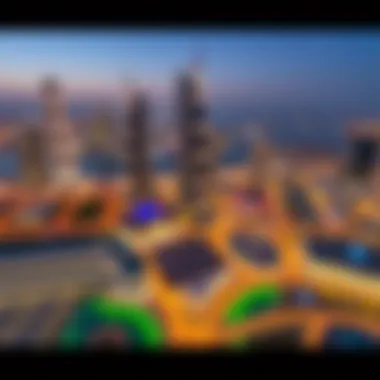
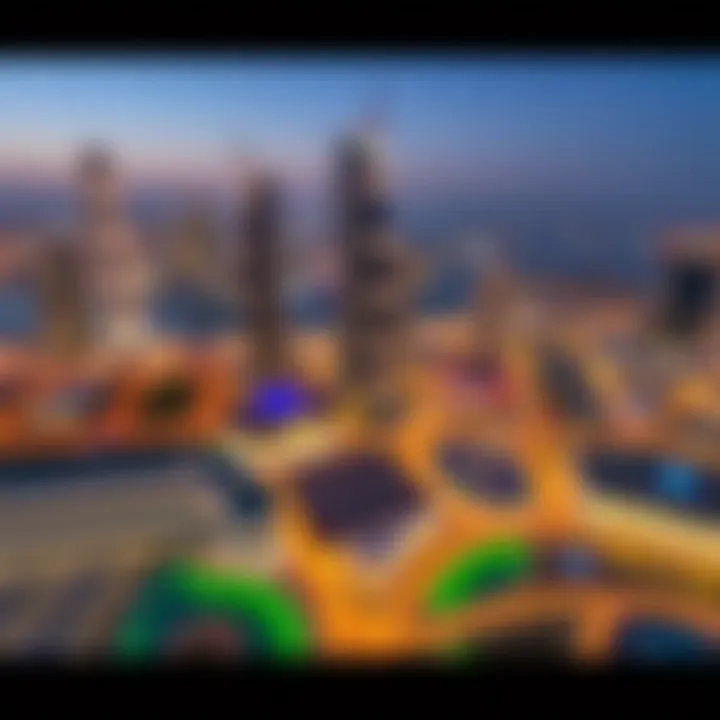
Intro
The Emirates Towers stand as a testament to modern architectural ingenuity and aesthetic brilliance. Nestled in the heart of Dubai’s bustling skyline, these twin structures serve not only as landmarks but also as symbols of the city's ambitious spirit. With their sleek lines and striking glass facades, they offer a stark contrast to the rich cultural tapestry of the UAE. Photographers and architecture enthusiasts alike are drawn to their unique form, prompting an exploration of how these towers encapsulate the essence of contemporary design in an ever-evolving urban environment.
As we journey through this analysis, it’s essential to appreciate not just the towers themselves, but also the impact they hold within the realm of real estate and investment opportunities. Given their prominence, the Emirates Towers provide insight into broader market trends while also offering a glimpse into the future of property development in Dubai.
In the ensuing sections, we will delve into the architectural significance of the Emirates Towers alongside the compelling photography that captures their essence. This exploration will be valuable for investors, real estate agents, and anyone passionate about the intersection of real estate and visual artistry.
Let’s peel back the layers of these architectural icons to understand better the story they tell—not just in terms of bricks and mortar, but also in the narratives they inspire through lens and light.
Preface to Emirates Towers
The Emirates Towers are not just mere structures; they are emblematic of Dubai’s rapid ascent as a global city. In this section, we delve into the implications of their design, construction history, and cultural significance, which contribute to a deeper understanding of their place within the urban landscape. The Emirates Towers redefine modern architectural standards, while also symbolizing the ambitious spirit of the UAE. Their unique silhouette graces Dubai’s skyline and is a focal point for real estate investments, attracting agents, investors, and homebuyers alike.
Historical Context and Construction
The conception of the Emirates Towers harks back to the 1990s, a period synonymous with the audacious growth of Dubai. Designed by the architect Hazel Wong, construction began in 1996 and was completed in 1999. The twin towers stand at 354 meters and 241 meters respectively, showcasing a perfect marriage of utility and art. The construction process involved meticulous planning and innovative methodologies that pushed the boundaries of architectural engineering. Utilization of reinforced concrete and steel not only ensured durability but also presented a striking aesthetic. Stories abound regarding the unique challenges faced during construction: from extreme weather conditions to logistical hurdles that demanded creative solutions. These details matter, as they contribute to the narrative of perseverance and ingenuity that defines the Emirates Towers’ existence.
Moreover, the towers are envisaged as a mixed-use development with both office and hospitality spaces. The addition of the Jumeirah Emirates Towers Hotel further solidifies their role as a cornerstone of Dubai’s commercial domain. High ceilings, expansive open spaces, and modern amenities combine to create an environment conducive to business, productivity, and luxury.
Architectural Inspiration
Drawing inspiration from the Islamic architectural heritage while embracing a modern aesthetic, the Emirates Towers reflect the city’s cultural tapestry. The design elements incorporate traditional motifs subtly while adhering to contemporary principles. The curved lines and glass facades create a sense of fluidity—characteristics that echo the ever-evolving skyline of Dubai.
It is noteworthy that the towers symbolize not just power and prosperity but also innovation in construction techniques. The use of advanced glass technology allows natural light to flood office spaces while minimizing heat gain—an essential feature reflecting Dubai's desert locale. The architectural design pays homage to both function and form, standing as a testament to the best of modern craftsmanship.
"The Emirates Towers are not just buildings; they are the embodiment of Dubai’s bold vision and dreams. They are a blend of awe-inspiring architecture and thoughtful design."
The Structural Design of Emirates Towers
To appreciate the Emirates Towers, one must first delve into the intricacies of their structural design. These towers are not just mere buildings; they symbolize innovation and architectural ambition, reflecting Dubai's progress on the global stage. The careful consideration of structural elements not only enhances their aesthetic appeal but also contributes to their functionality and longevity.
Material Choices: Glass and Steel
When discussing the Emirates Towers, the materials chosen for their construction are pivotal. The primary materials—glass and steel—serve a dual purpose: they provide structural integrity while creating a visually stunning facade.
- Glass is used extensively in the towers, allowing for abundant natural light to permeate the interior spaces. This choice creates an airy feel and offers panoramic views of the Dubai skyline, significantly enhancing the overall experience for occupants and visitors alike.
- Steel, on the other hand, provides the necessary strength to support the towers' impressive height. The use of structural steel beams not only ensures stability against high winds but also allows for innovative design features like cantilevered sections, which break from traditional forms.
Ultimately, the combination of glass and steel is a hallmark of modern skyscraper design. It is a testament to the merging of functionality and beauty, giving the Emirates Towers a distinctive character. The reflective glass panels gracefully interact with the sunlight, creating a sparkling sensation that captures the essence of Dubai's vibrancy.
Height and Proportions
The height and proportions of Emirates Towers are nothing short of remarkable. Standing tall at 355 meters, they are among the tallest structures in Dubai. However, it is not just their height that commands attention; it is how that height is proportioned in relation to their surroundings.
- The towering structures are designed in harmony with the landscape, ensuring they do not overpower the skyline but instead complement it. This balance is essential in architectural design, particularly in a city defined by its eclectic skyline.
- Furthermore, the facade's rhythmic patterns, created by the placement of windows and structural elements, contribute to the visual weight of the towers. Such careful consideration of proportions ensures that while the towers reach for the skies, they maintain a sense of elegance and grace.
A visit to the Emirates Towers is an experience that showcases how height can be achieved without sacrificing artistry or functionality. Their design is thoughtful, creating a dialogue between the built environment and the natural world, ideal for both work and leisure.
"Emirates Towers stand as a testament to how architectural engineering can push boundaries while respecting its environment."
The Significance of Photography in Architecture
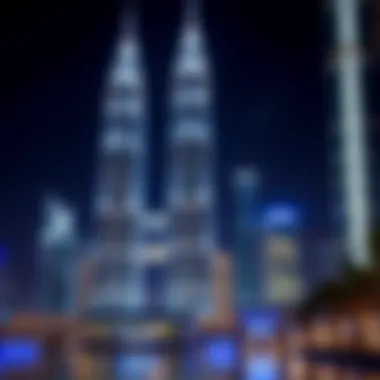
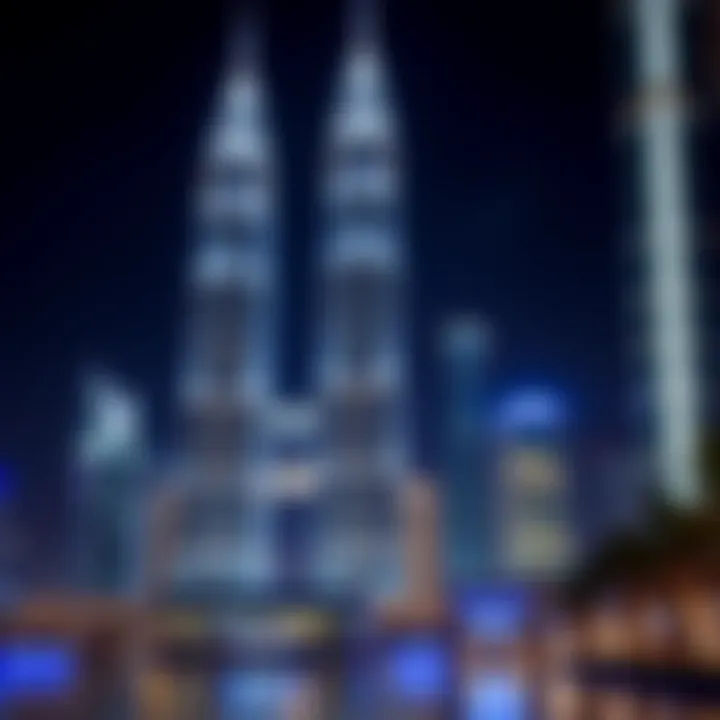
Photography plays a crucial role in architecture. It not only serves as a means of documentation but also creates a narrative around the structures we build. Through photography, the stories told by architectural designs can resonate widely. In the context of Emirates Towers, the interplay of light, shadow, and atmosphere against this modern marvel significantly enhances its allure.
Capturing Light and Shadows
Light and shadows work like two sides of the same coin in the realm of architecture. When a photographer takes a shot of Emirates Towers, they are not just framing a building. They are capturing the transient qualities of daylight that can change the perception of the towers throughout the day. For instance, during sunrise or sunset, the surfaces of glass and steel can elicit a symphony of colors, showcasing not just the shape but the very essence of the structure. The warm hues contrast sharply with the shadows cast by the towers, creating a playfulness that is visually striking.
- Golden Hour Shots: The windows of Emirates Towers reflect the golden and pink hues of the morning or evening sun, which is often the preferred time for many photographers to visit. This timing allows them to capture the building in a gentle light that softens its strong lines.
- Shadow Play: The intricate designs of the towers lead to dynamic shadow formations, especially on the pavement below. These shadows create dramatic patterns, adding depth to photographs and leading viewers’ eyes into the frame.
Utilizing the natural light not only tells a story about the design of Emirates Towers but also gives a sense of the atmosphere and environment surrounding it. Thus, capturing light and shadows is essential for conveying the true character of these iconic structures.
Perspective and Scale
Perspective can dramatically influence how a viewer engages with a structure. When photographing Emirates Towers, perspective can change a picture from a simple architectural shot to an evocative composition.
- Vantage Points: Photographers often seek out unique angles that showcase the towers' towering height and sleek design. Whether it's from the base looking up or from a distance capturing the skyline, these perspectives give a sense of scale that ground-level shots often miss.
- Human Element: Including people in photographs can accentuate scale, adding a relatable context to the grandeur of Emirates Towers. A small figure in the foreground can highlight the sheer size of the structure, creating a striking contrast.
Moreover, experimenting with a wide-angle lens can warp the perspective, bringing out a more engaging and dynamic view of the towers. Such techniques can transform the mundane into the extraordinary, providing a fresh take on a well-known building.
"Photography in architecture isn't just a technical process; it's an art form that breathes life into structures like Emirates Towers, revealing their true magnificence through the lens."
By mastering the significance of light, shadows, and perspective, photographers not only record but also interpret architectural treasures, creating a dialogue that transcends the visual, inviting viewers to engage deeply with the built environment.
Iconic Photographic Angles of Emirates Towers
When it comes to capturing the essence of monumental structures, the angle from which a photograph is taken significantly shapes the viewer's perception. Understanding the iconic photographic angles of Emirates Towers is not just about artistic expression; it's about revealing the narrative embedded in each shot. As this stunning architectural feat graces the skyline of Dubai, photographers—be they professionals or enthusiasts—stand to learn much from the various perspectives that promise to illuminate different aspects of these towers.
Ground-Level Views
Ground-level views of Emirates Towers provide a unique perspective that communicates scale, space, and the surrounding urban environment. When a photographer kneels down or captures the scene from street level, they create an image that is relatable, embodying the experience of being part of the bustling life surrounding the towers.
Certain techniques enhance the impact of ground-level shots:
- Leading Lines: Streets or walkways can guide the viewer’s eye towards the towers, creating depth in the image. Incorporating these elements can draw attention to the height and elusiveness of the structures.
- Foreground Elements: Introducing trees, vehicles, or even pedestrians can add context and power to the portrayal. The juxtaposition between these elements and the glass-and-steel facades helps convey the idea of modernity within an active city landscape.
Capturing Emirates Towers at dawn or dusk can also provide a stunning effect, with the soft glow of the sun's first or last rays reflecting off the glass. Shadows produced at this time can enhance the visual drama.
Aerial Photography
Aerial photography stands as a game changer in the world of architectural representation, especially for tall structures like Emirates Towers. When observed from above, the buildings take on an entirely new dimension. This viewpoint emphasizes their grand scale and relationship to their surrounding city.
Photographers can utilize drones or other aerial platforms to achieve these dynamic views. Some notable benefits of aerial photography include:
- Unique Perspectives: Capturing Emirates Towers with the sprawling cityscape beneath them enhances the grandeur and demonstrates their prominence in the skyline.
- Composition: Aerial shots can capture symmetrical designs or intersecting lines that might be missed from the ground, offering a fresh take on the towers’ architectural lines.
- Contextual Depth: With the city laid out beneath, aerial photographs can showcase how Emirates Towers interconnect with surrounding structures, allowing viewers to appreciate urban planning and development.
However, photographers should mind the regulatory aspects of drone photography in urban areas, ensuring they comply with local laws and guidelines pertinent to aerial imaging.
Reflections in Surrounding Glass
The use of reflections in surrounding glass makes for a captivating photography topic, particularly with the sleek surfaces of Emirates Towers. This technique not only offers a whimsical quality to images but also introduces a layer of complexity that can be visually stunning.
Here's how to effectively utilize reflections:
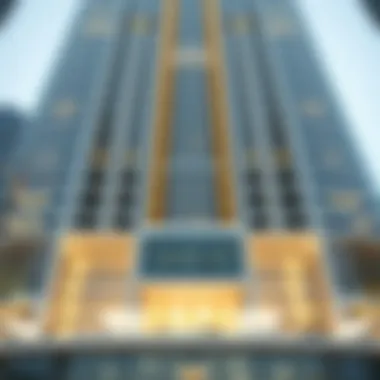
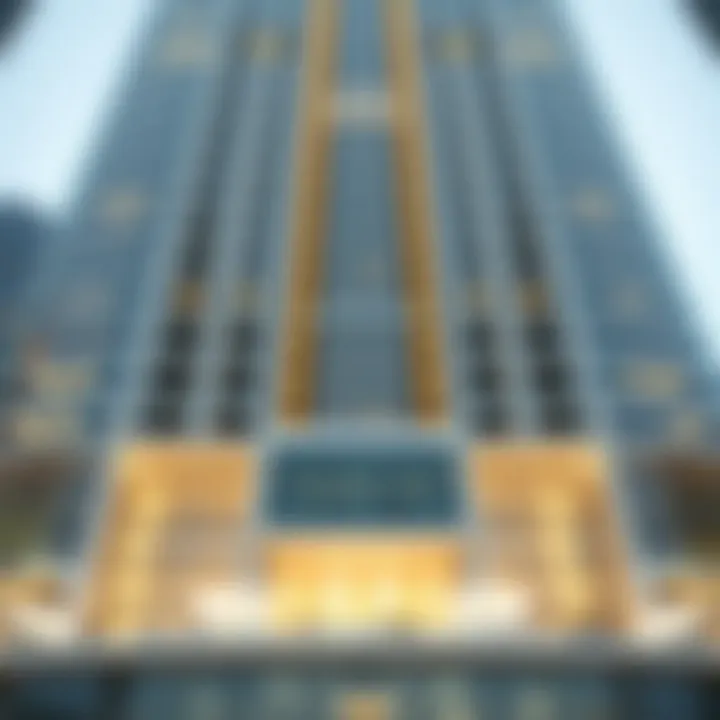
- Layering: Including reflections can create depth in the photographs, merging the tower’s imposing façade with elements of the environment—like other buildings or natural landscapes.
- Color Play: The reflective surfaces capture light and color from their immediate environment, contributing to a dynamism that is dependent on the time of day and the weather conditions.
- Artistic Interpretations: Reflection photography gives a chance to explore more abstract compositions. The distorted images that appear can evoke feelings, encouraging viewers to engage with the scene on a more emotional level.
Photographers should experiment with various times of the day, as different lighting conditions greatly affect how reflections are captured and perceived. This artful mix of real and perceived images tells the story of the Emirates Towers in an intricate and engaging way.
In the realm of architectural photography, angles can redefine a structure's narrative, turning a simple image into a powerful visual experience.
By carefully considering these dynamic angles when photographing Emirates Towers, the resulting images can capture not only the physical beauty of the buildings but also the energy and life of Dubai itself. This attention to the nuances of perspective allows for a deeper understanding of the towers' architectural prominence and significance in the urban landscape.
Emirates Towers in Dubai’s Skyline
The Emirates Towers not only dominate the skyline of Dubai but also serve as landmarks that reflect the city's rapid growth and opulence. These soaring structures encapsulate the spirit of modernity, standing tall as a testament to innovative architectural design amidst the bustling urban environment. Understanding their significance helps us appreciate their role in shaping Dubai's identity.
The noteworthy silhouette of the Emirates Towers is marked by their distinct rectangular and triangular shapes, which harmoniously blend with other structures, including the Burj Khalifa and the Dubai Mall. More than just buildings, they represent a fusion of functionality and aesthetic appeal. In addition to housing offices and a luxury hotel, they symbolize Dubai’s leap into the global arena, attracting tourists and investors alike.
This iconic architectural duo is emblematic of the economic transformation that the United Arab Emirates has undergone, shifting from an oil-dependent economy to a diverse one characterized by tourism, trade, and real estate investments.
"The Emirates Towers aren't just structures; they are a symbol of a prosperous future and a beacon for international commerce."
Cultural and Economic Impact
The presence of the Emirates Towers is not just about aesthetics; they serve as a pivotal interaction point for culture and economy within Dubai. On a cultural front, the towers host various events and exhibitions that highlight the rich heritage and contemporary art of the UAE. Furthermore, they act as a stage for global exchanges, linking local society with international entities.
Economic-wise, the Towers significantly contribute to Dubai's position as a global business hub. The offices within these structures attract multinational corporations, thereby fostering an environment of innovation and collaboration. Real estate trends indicate that the areas surrounding the Emirates Towers see a spike in property values, demonstrating the ripple effect of their presence. From restaurants to shopping boutiques, the vicinity thrives on both local and international patronage.
Comparison with Other Landmarks
When measuring the Emirates Towers against other global icons, a few distinguishing features arise. The Burj Khalifa stands as the tallest structure, yet the Emirates Towers are distinguished by their architectural cohesiveness with the urban landscape.
Key Comparison Points:
- Architectural Style: While Burj Khalifa boasts a unique spire design, the Emirates Towers reflect a straightforward yet elegant modernism.
- Functionality: The Emirates Towers seamlessly integrate residential, commercial, and leisure spaces, fostering a sense of community, versus the Burj Khalifa primarily serving as an observation point and hotel.
- Cultural Influence: Unlike structures like the Eiffel Tower or Empire State Building, Emirates Towers embody Middle Eastern cultural motifs while also embracing a sleek, international style.
These comparisons underline the unique role Emirates Towers play—not merely as individual structures but as vital components of the fabric of Dubai's architectural narrative. Ultimately, their significance stretches beyond mere aesthetics to encompass cultural relevance and economic vitality.
Navigating Photography Techniques
Photography is not just about capturing images; it is also about evoking emotions and telling stories. In the context of the Emirates Towers, effective photography techniques play a vital role in highlighting the architectural brilliance and their surroundings. Understanding the various methods can enhance the aesthetics of this iconic structure, making images more appealing to viewers, especially those involved in real estate and investment decisions.
Capturing the essence of the Emirates Towers goes beyond simple snapshots. It requires a strategic approach, leveraging modern technology and skills. Here are some essential techniques that can elevate the photographic representation of this architectural marvel.
Using Drones for Unique Angles
Drones have transformed the way photographers approach architectural photography. Utilizing a drone can provide a unique aerial perspective that is unattainable by traditional methods. The Emirates Towers, with their striking design and placement in the Dubai skyline, lend themselves beautifully to this technique. A drone can hover at various heights, enabling photographers to adjust angles and capture sweeping panoramic views.
When employing drones, consider the following:
- Weather Conditions: Clear skies can significantly enhance the visual quality. Early mornings or late afternoons are often ideal for soft sunlight, reducing harsh shadows.
- Flight Regulations: Familiarize yourself with local drone laws in Dubai. Certain areas may have restrictions, especially around urban centers.
- Battery Life: Drone flights can be limited by battery power, so plan ahead to make the most of your session.
This technique not only captures the physical beauty of the Emirates Towers but can also showcase the bustling life of Dubai that surrounds them, thus providing a fuller context in images.
Night Photography Essentials
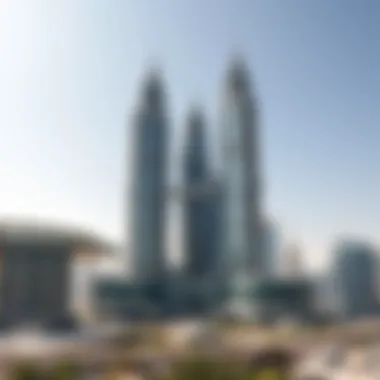
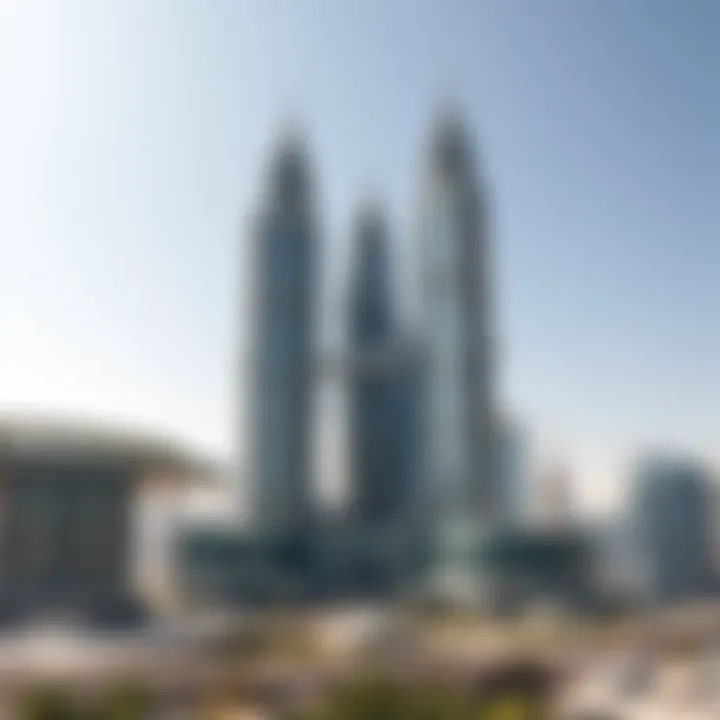
Night photography brings a unique charm and atmosphere to architectural shots. The Emirates Towers transform when the sun sets, illuminated by thousands of lights reflecting off their glass facades. Photographing these towers at night requires a different skill set and approach:
- Long Exposure: Use long exposure settings to capture light trails from traffic below, juxtaposing the stationary structure against the dynamic movement of the city.
- Tripod Requirement: Stability is key when working with long exposure. A sturdy tripod will prevent image blurriness and ensure sharpness.
- Use of a Timer: To avoid shaking the camera at the moment of capture, consider using a timer or remote shutter release.
The lights of the Emirates Towers not only accentuate their structure but also create captivating reflections on the water features in the vicinity, adding another layer of depth to the photographic narrative.
Post-Production Techniques
Post-production is where the magic can often happen; it’s not just about editing photos, but refining them to convey the intended mood. In the context of photographing the Emirates Towers, it is essential to pay attention to:
- Color Correction: Adjusting the color balance can make the tranquil blues and radiant golds stand out more vividly. This is particularly important for evening shots that may look too warm or too cool if unadjusted.
- Crop and Composition: Sometimes, a shot requires cropping to enhance focus on the towers. This can help direct the viewer’s attention and create a more compelling image.
- Sharpening and Noise Reduction: Use sharpening tools judiciously to enhance detail and reduce noise that might be more pronounced in low-light images.
Utilizing these post-production techniques allows for a polished finish on photographs, ensuring they resonate well with both investors and general viewers who appreciate the artwork in architectural photography.
Navigating these photography techniques is crucial for those wanting to truly capture the spirit of the Emirates Towers. By combining innovative technology and artistic vision, one can translate the magnificence of this architectural icon into impactful visual stories.
Emirates Towers and Real Estate Trends
The Emirates Towers stand as a landmark in Dubai, holding significance not solely for their architectural splendor but also for their impact on real estate trends within the region. The towers serve as a bellwether for the dynamic property market of the city, reflecting both the aspirations and the complexities of real estate investing in one of the world’s fastest-growing urban areas.
The importance of analyzing real estate trends related to Emirates Towers lies in several aspects: the iconic status of these structures, their role in shaping the commercial landscape, and their influence on property valuations in the surrounding areas. Investors, homebuyers, and developers need to grasp these trends to make informed decisions.
Current Market Analysis
The current real estate market surrounding Emirates Towers exhibits a mix of resilience and fluctuation. In recent months, property values have shown signs of recovery as the Dubai economy bounces back from disruptions caused by various global events. For instance:
- Commercial Real Estate: Office spaces in the Emirates Towers area remain highly sought after, driven by the presence of multinational corporations and financial institutions. Vacancy rates have declined, suggesting a healthy demand.
- Residential Segments: The area sees a growing interest from expatriates and local families, drawn by the prestige associated with living near such an iconic structure. Luxury apartments and penthouses in the vicinity fetch premium prices, fostering a competitive marketplace.
- Investment Opportunities: New developments are underway, aiming to complement the Emirates Towers’ stature. This provides opportunities for potential investors looking to capitalize on commercial and residential projects that attract affluent clients.
Understanding the nuances of property trends in this area can yield significant benefits for stakeholders. Buyers keen on purchasing property must consider the ongoing growth and infrastructural developments while strategizing their investments carefully.
Future Predictions
Looking ahead, the outlook for real estate trends tied to Emirates Towers appears promising, albeit influenced by various factors that could reshape market landscapes. Some anticipated directions include:
- Sustainability Initiatives: As Dubai pushes towards sustainability, new developments may emphasize green architecture and eco-friendly practices. This shift will likely affect property demand and could increase the value of sustainably developed projects around Emirates Towers.
- Social Shifts: The post-pandemic world has changed how people view work and living spaces. Flexibility and remote working options are becoming more commonplace, leading to adaptations in office spaces and residential layouts.
- Technological Advances: Emphasis on smart city initiatives may drive the integration of technology in new developments. Properties equipped with advanced tech features, smart home capabilities, and enhanced security will likely attract high-value tenants.
The Emirates Towers not only symbolize luxury but also embody the evolving real estate landscape of Dubai. Stakeholders who remain astute regarding these trends and predictions can navigate this vibrant market with greater assurance. In a city known for its rapid pace, the Emirates Towers will continue to be a focal point of real estate activity, shaping both the skyline and investment opportunities.
End
The concluding segment of this article holds significant weight, as it encapsulates the essence of what has been explored throughout the various facets of Emirates Towers. The culmination of architectural elegance, coupled with the art of photography, has solidified these towers not just as structures but as pivotal components of Dubai's urban narrative. This analysis illustrates that photography is more than a mere visual representation; it plays a crucial role in conveying the spirit and relevance of architectural masterpieces.
The Ongoing Relevance of Architectural Photography
Architectural photography continues to thrive, propelled by the demand for aesthetic storytelling in the real estate market. Today, with high-quality imagery easily accessible, prospective buyers and investors often make decisions based on the visual appeal of properties. This intersection of architecture and photography is particularly evident in the way Emirates Towers resonate with viewers. Photographers capture not only the sleek lines and glass facades but also the interplay of light that accentuates the towers' unique structure.
"Good architecture is not just seen; it is felt through the lens of a camera, allowing prospective clients to envision themselves within its space."
In an age dominated by social media and instant visuals, the importance of striking architectural photography cannot be overstated. It influences perceptions and aids in marketing real estate, offering insights into the lifestyle associated with specific locations. Additionally, architecture and photography form a symbiotic relationship where one enhances the understanding of the other, allowing both disciplines to thrive.
Why Emirates Towers Matter
The Emirates Towers stand out as a beacon of modern architecture and symbolize the economic progression of Dubai. These towers epitomize luxury, innovation, and ambition. Their presence in Dubai's skyline not only signifies the city’s architectural aspirations but also speaks volumes about its global standing in business and tourism.
Several key reasons underline the importance of Emirates Towers in both architectural and real estate contexts:
- Economic Significance: Emirates Towers play a pivotal role in Dubai's economy, housing numerous corporate offices, luxury hotels, and retail spaces that drive commerce and tourism.
- Architectural Innovation: The design triumphs of the Emirates Towers present valuable lessons in integrating modern aesthetics with functionality, inspiring budding architects and investors alike.
- Cultural Heritage: These structures contribute to the evolving narrative of Dubai, marrying tradition with modernity, showcasing the Emirate’s journey toward a global metropolis while maintaining a unique cultural identity.















